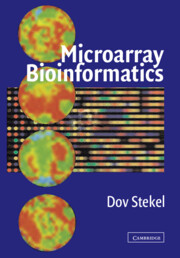Book contents
- Frontmatter
- Contents
- Foreword
- Preface
- Acknowledgments
- MICROARRAY BIOINFORMATICS
- 1 Microarrays: Making Them and Using Them
- 2 Sequence Databases for Microarrays
- 3 Computer Design of Oligonucleotide Probes
- 4 Image Processing
- 5 Normalisation
- 6 Measuring and Quantifying Microarray Variability
- 7 Analysis of Differentially Expressed Genes
- 8 Analysis of Relationships Between Genes, Tissues or Treatments
- 9 Classification of Tissues and Samples
- 10 Experimental Design
- 11 Data Standards, Storage and Sharing
- Appendix: MIAME Glossary
- Index
- Plate section
2 - Sequence Databases for Microarrays
Published online by Cambridge University Press: 15 January 2010
- Frontmatter
- Contents
- Foreword
- Preface
- Acknowledgments
- MICROARRAY BIOINFORMATICS
- 1 Microarrays: Making Them and Using Them
- 2 Sequence Databases for Microarrays
- 3 Computer Design of Oligonucleotide Probes
- 4 Image Processing
- 5 Normalisation
- 6 Measuring and Quantifying Microarray Variability
- 7 Analysis of Differentially Expressed Genes
- 8 Analysis of Relationships Between Genes, Tissues or Treatments
- 9 Classification of Tissues and Samples
- 10 Experimental Design
- 11 Data Standards, Storage and Sharing
- Appendix: MIAME Glossary
- Index
- Plate section
Summary
INTRODUCTION
Chapter 1 introduced microarray technologies and discussed the use of microarrays in the laboratory. The remainder of the book is dedicated to microarray bioinformatics. This chapter, together with the next chapter, discusses the bioinformatics required to design a DNA microarray. In this chapter, we look at the sequence databases that are used to select and annotate the genes that the microarray detects and, thus, the sequences that will appear on the array. Chapter 3 looks at the computer design of oligonucleotide probes for oligonucleotide arrays.
There are two broad questions and one more specific consideration that this chapter seeks to address:
1. What resources could I use to design my own custom array?
If you are designing a custom microarray to study a particular disease, tissue or organism, you will need to identify the genes that might be expressed in your samples and identify the sequences of those genes. One of the aims of this chapter is to give an understanding of which databases you could use to select such genes.
How can I find more information about the sequences of the genes on my array?
DNA microarrays contain sequences that will have derived from DNA sequence databases. The output file containing the numerical results of the microarray experiment that you will analyse also contains a number of fields that relate these sequences to the databases from which they derive. This chapter describes the meanings of these fields and the nature of the databases.
- Type
- Chapter
- Information
- Microarray Bioinformatics , pp. 19 - 42Publisher: Cambridge University PressPrint publication year: 2003



